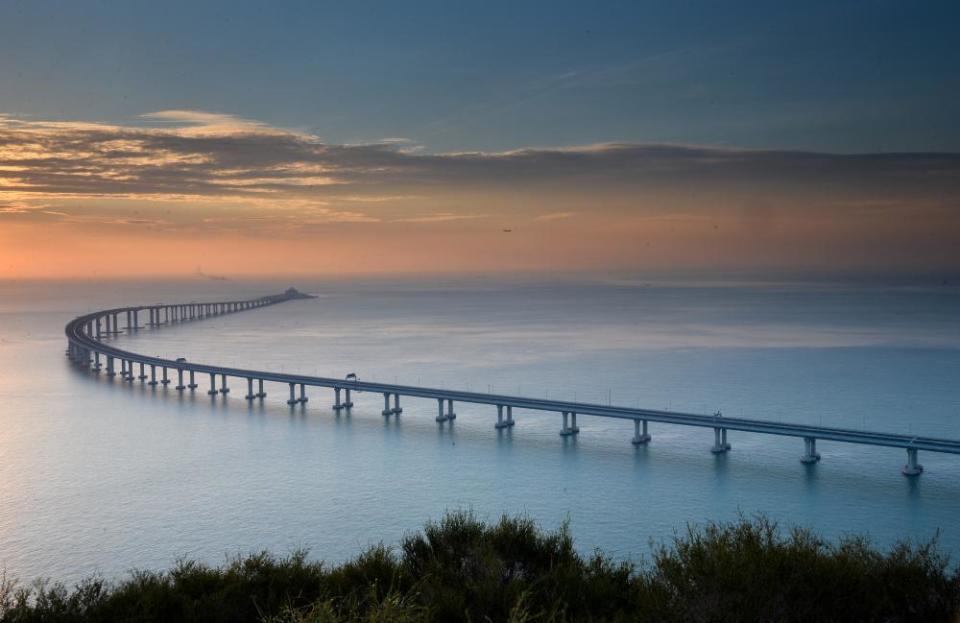World's longest sea bridge to open ... but only to drivers with a special permit

The world’s longest sea bridge is set to open this week, linking the cities of Hong Kong and Macau to the Chinese mainland as part of a broader contentious plan to integrate the special administrative regions into China.
The $20bn Hong Kong-Zhuhai-Macau bridge officially opens on Tuesday in a ceremony that Chinese president Xi Jinping is reportedly planning to attend. Officials are billing the 55km bridge as a key part of the Greater Bay Area plan, a campaign to connect Hong Kong and Macau to 11 Chinese cities to form a high-tech region to rival Silicon Valley.
The bridge links Hong Kong’s Lantau island to Zhuhai on the southern coast of Guangdong province and the gambling hub of Macau, a popular tourist spot for Chinese visitors.
“The bridge is not just a mega transport infrastructure jointly built by Guangdong, Hong Kong and Macau,” Hong Kong’s secretary for transport and housing, Frank Chan Fan, said on Friday.
“The collaboration between Guangdong, Hong Kong and Macao in terms of trade, finance, logistics and tourism will be strengthened. Hong Kong will assume a more proactive role in the development of the Greater Bay Area.”
However, private cars will only be able to use it after applying for a special permit.The crossing will mostly be used by private shuttle buses and freight vehicles. The bridge is not served by public transport.
Since its inception, it has been one of the most criticised initiatives in Hong Kong, where residents believe it is a poor use of taxpayer funds. Conservationists have blamed bridge construction for falling numbers of the threatened Chinese white dolphin. Others say the bridge is another way for Beijing to bind the autonomous administrative regions closer to China.
“It is a politically driven mega-project without urgent need,” said pro-democracy lawmaker Eddie Chu. Earlier this year, officials said traffic on the bridge would see about 25% less traffic by 2030 because of another competing bridge. “Basically it is redundant,” he said.
Under construction since 2009, the structure is supported by three cable-stayed bridges and designed to withstand winds of up to 340km an hour. A 6.7km undersea tunnel has been built to avoid disrupting shipping lanes, connected by two artificial islands.
Towers above the bridge are designed to look like dolphins, in honour of the white dolphin, Chinese knots and a boat’s mast, according to the bridge’s designer. The curves of the road are meant to resemble a snake.

Photograph: Bobby Yip/Reuters
Originally slated to open in 2016, the bridge has been dogged by construction delays, budget overruns, and safety issues. Nine workers have died and more than 200 others have been injured building the bridge. This year, six subcontractors have been fined for endangering workers.
Earlier this year, concrete blocks around the artificial island appeared to be floating away, prompting criticism of the quality of the bridge. Officials said the placement was deliberate.
Some say the bridge is not needed, given existing transport links to mainland China. “I don’t think people are too excited about it. It’s been dragged on for so long and it’s so expensive, and there are already means of going to the western side of the Pearl River Delta,” said Mee Kam Ng, a professor at the department of geography at the Chinese University in Hong Kong.
In some ways, the bridge does advance integration of the three cities. Commuters on the bridge will go through three different checkpoints for Hong Kong, Macau, and Zhuhai.
“From the opening of the bridge to the eventual integration of these three different places, with three different sets of institutions, regulatory regimes, and very different histories and cultures, it is an interesting experiment,” Ng said.


 Yahoo News
Yahoo News 